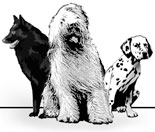Habituation -- July 20, 2007
Well, yes, it has been a VERY long time since I’ve managed to write about my little enigma. Yet so much has been going on with him that the longer I wait, the more difficult it is to get back into it because I don’t know where to start! So I’ve decided that I’ll begin where I have some photos to share.
The other day, I was once again pondering exactly HOW I am going to help Bing with his love/hate relationship with the car. This is not exactly a precise description of the relationship, however. There is nothing, per se, that he “hates” about the car. He loves to get into it, he loves to go places, for sure. But while he is in the car, he is anxious. For the first several minutes, he wanders around from front to back, side window to side window, but mostly trying to get whatever human is in there to pet him. While that human is petting him, he is somewhat calm, but licks that hand/arm nonstop. The moment the hand stops petting, he begins to become frantic again.
Some time ago, I made the decision to stop crating him in the car. His behavior in the car is generally tolerable, with a few exceptions. The problems come when he is left in the car; he takes moment to chew through a seatbelt as if his mouth were a box cutter. Therefore, leaving him in the car and not in a crate is not an option. Leaving him in the car in a mesh travel crate is also not an option! He shredded his way straight through the crate and through the seatbelt in moments. Sigh.
For what it’s worth, this process is a lot like shaping in that he is rewarded at each level with getting one step closer to actually going somewhere. That means there is much operant conditioning going on, where he is using his brain to figure out what to do. But I am not using a marker (clicker or word) because those things tend to have the opposite effect on him than the one we want. We are awaiting habituation at each and every level, until we have a calm dog.
Long term project? You bet. But a necessary one…we will be driving to Arizona this fall, with Acacia and Bing. If we don’t have it down to perfection by then, we will have loads of opportunities to work on it on the trip!
I’ll keep you posted on the progress.
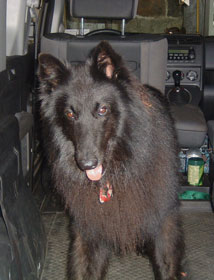
Waiting for the tailgate to close. Note the slightly crouched, ready-to-pounce posture and the glazed eyes. It's hard to tell from this photograph that he freezes in this position.
My experience with Bing is that using positive reinforcement training (clicker training, and in particular, free shaping) has the opposite effect from what I want to get from him when he is in arousal mode. It hypes him up even more; he seems to be a performance machine! He LOVES to work and to free shape. Simple classical conditioning is unlikely to work, as we cannot place him in an environment far enough away from the stimulus (the car) consistently enough to actually be able to take him anywhere. The process is prohibitive because it would mean he could be home-bound for months to years! Fortuitously, I recently had the opportunity to spend a day in NYC, working on the validity of test questions for the CPDT exam. One of the many topics we discussed included the concept of “habituation”. YES! That’s it!
What’s habituation? It’s the principle of putting the dog in a mildly stimulating environment until it’s no longer a big deal, and then increasing the distraction/excitement level a bit, and waiting until that is no longer so exciting. At each step, a period of time must go by until the dog shows calm behavior; that calm behavior is the cue to the person to move up to the next level. It also happens to be reinforcing to the dog’s calm behavior. This is what we have to do!!
Realizing that this is not healthy, Pete and I decided to get rid of the metal crate in the car and work out an alternative plan. We experimented with having him loose in the car. Acacia is so calm that it seemed impossible that he wouldn’t learn something from her. Hunh. We were wrong! Initially, he was calmer when we were getting into the car. Over time, however, his arousal level continued to escalate, and then he began the ‘attack’ sequence when the humans began to get in the car, lunging, grabbing clothing, etc. When I finally got a nice bruise on the back of my upper arm, I had had enough.
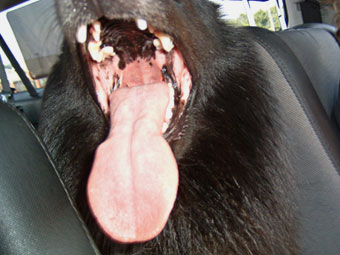
Bing's mouth can really invade your space.
So, you stupid know-it-all trainer, you say, “why did you stop crating him, then?” The real answer is that we couldn’t stand the constant barking. He LOVED to get into the crate in the car…we couldn’t keep him out of it. But the moment the crate door closed, the back hatch closed, the human got in, sat down, closed the door…each one of those things escalated his frantic barking to the point where he was completely “hindbrain”. When a dog is hindbrain, he is not thinking at all; he is in reactive mode. His eyes glaze over, he shows his whale eye, he assumes a lowered posture of readiness to pounce, he freezes. And he drools.
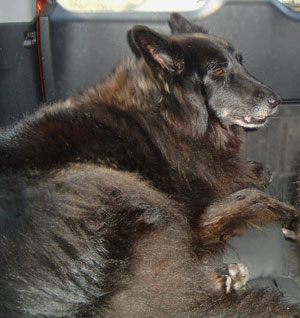
Acacia gets very comfortable in the car. We call it C.I.C. -- "car induced coma." It makes her a great traveling companion.
Ali
Comments about this blog, email pete@e-production.net, (your comments may be posted).
Return to the Main Blog Page.
Send email to Ali Brown
Oh boy. It’s going to be a loooong path! But it just simply must be done. I took the opportunity one evening when I was cleaning out my car (long overdue!) to allow Bing to be in the car with me, just hanging out. His ability to be calm vacillated, but the more I moved, the more aroused he became, until at one point, if he were not my dog, I would have been worried to be in the car with him, such was the expression on his face. He was truly scary. Now, I know very well that he wasn’t going to respond poorly to me, but the look was enough to tell me that this needed to change.
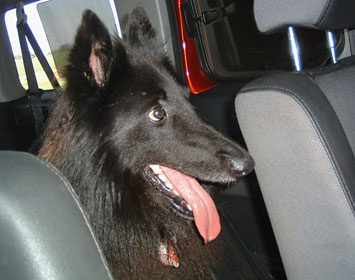
Bing anxiously waits for me to take my seat. Note the whale-eye and pulled-back commisures (corners of his mouth).
Bing Blog 32
